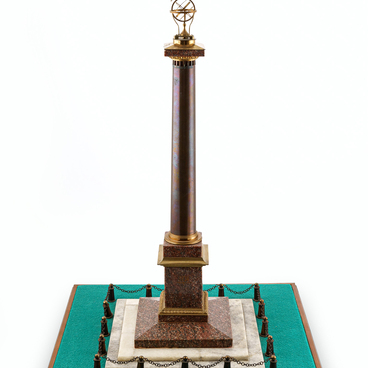The exhibition presents a color copy of the icon’s border scene, made on a rectangular sheet of paper, decorated in a passepartout. The bottom is made of thick cardboard, and on the front side there is a rather narrow frame made of beige paper. The scene of the battle is depicted in an iconographic manner. On the left, there is a mounted army with flags coming out of the city, above whose high gray-green walls the domes of churches and roofs of buildings can be seen. Below, on the left, people stand in an arched opening. On the right is a second mounted army with flags, with tents visible in the background. The center, where the two armies clashed, shows fallen horses and warriors.
Valery Pavlovich Zub, an exhibit artist and member of the Union of Artists of Russia, created this work. He was born in 1946 in Vichuga, Ivanovo region, and graduated from the Yaroslavl Art School. His easel works are housed in museum collections of Yaroslavl, Rybinsk, Pereslavl-Zalessky and in many private collections.
On July 16, the Russian Orthodox Church celebrates the memory of Faithful Princes Vasily and Konstantin of Yaroslavl. This day is associated with the revolt of the Yaroslavl people against the Mongol-Tatar yoke, the legendary battle on Tugovaya Mount. The legend of the battle as an episode of the heroic struggle of Yaroslavl citizens against the Mongol-Tatar yoke existed in oral legends and is not supported by historical sources. In 1257, under Khan Berke a census of the population of Suzdal, Ryazan and Murom lands was conducted in order to ensure the collection of tribute. As the legend says, Yaroslavl residents expelled the khan’s census takers from the city. In response, the Tatars sent a punitive detachment. On July 3, 1257 Tatars approached Yaroslavl from the direction of Rostov. Yaroslavl prince Konstantin Vsevolodovich marched against the enemy with a numerous retinue. The battle took place in a suburb of Yaroslavl, behind the Kotorosl river, on the mountain named later Tugovaya. Yaroslavl citizens fought bravely, but the forces were unequal. The battlefield was covered with the bodies of the defenders of the city fallen in battle. Prince Konstantin Vsevolodovich was among the victims. At the end of the battle the wives and children of the killed came to the site.
The legend says, “The sound of swords and military
trumpets was replaced by the groans and wails of inconsolable grief of the
bereaved, for a long, long time thereafter. The people of Yaroslavl came to the
place of battle to weep and mourn for the slain”. Tugovaya Mount (the mountain
of sorrow, grief) has retained its name to this day. Archaeological research
has not yet confirmed the legend of the great battle.

